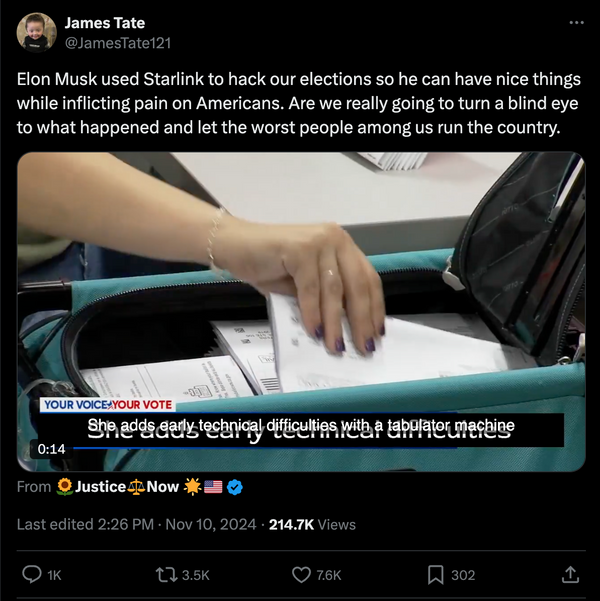No Evidence Musk’s Starlink Network Was Used To ‘Rig’ 2024 Election
Elon Musk’s Starlink satellite network was used to tally swing state votes during the 2024 election, allowing him to “rig” or “hack” the election in favor of Trump.
After the 2024 presidential election in the U.S., a rumor started to spread that Elon Musk, founder of SpaceX and supporter of Republican President-elect Donald Trump, had rigged the result of the election using Starlink, Musk’s satellite internet company. This claim is unfounded, as will be explained below.
One post amplifying the rumor on X included a video clip of a report on the connectivity of Tulare County in California’s Central Valley (archived):

(@JamesTate121 / X)
“Elon Musk used Starlink to hack our elections so he can have nice things while inflicting pain on Americans,” the post read. The video said:
Registrar Michelle Baldwin says access to connectivity was improved this year thanks to Starlink satellite internet. She adds technical difficulties with a tabulator machine were quickly fixed and did not impact the count. Five of the 10 volunteers assigned to the Exeter poll location did not show up, but Baldwin says all of the sites still ran smoothly.
This X post had gained 214,500 views and 7,600 likes as of this writing, but this claim and questions surrounding it appeared several times on the social media platform, as well as on Reddit, and TikTok.
The video was part of a longer news report by ABC30, a television channel in Fresno, California. The report indicated that the election process had gone well in Tulare County, a rural area of the state. But the flurry of suspicions reached Snopes readers as well, who emailed us asking to confirm if Musk had indeed used his company to rig the election.
One post on X (archived) referred to a nine-minute video by TikTok user @etheria77 which it said had been viewed 1.6 million times. While we could not find the video on the user’s TikTok profile page — another video on Nov. 11, 2024 saying it had been removed — it appeared on X (archived):

(@AesPolitics1/X)
In the video, the user claimed to have her “CCIE” — the Cisco Certified Internetwork Expert certification, a notoriously difficult certification to obtain, with a pass rate of about 26%. “California and other swing states were able to use Starlink in order to tally up and to count voting ballots in their state,” she said.
Many who viewed the video demanded that the allegations be investigated, arguing that it was unethical that a company owned by a Trump supporter should be involved in the election process.
Fueling the claims was another video clip of podcaster Joe Rogan, who endorsed Trump before the election. In it, Rogan claimed that Musk had an app that allowed him to confirm the election results four hours before they were announced (archived):
Apparently Elon created an app and he knew who won the election four hours before the results. So as the results were coming in, four hours before they called it, Dana White told me Elon was like ‘I’m leaving, it’s over, Donald won.”
But the reality is that the vast majority of voting machines have no connectivity, as the federal certification requires voting systems to be “air-gapped” from other networks — that is, entirely independent. It also does not allow machines to be equipped with wireless technology such as Starlink, WiFi or Bluetooth.
When ballot scanners are connected to anything, it is typically a closed network, used only to transmit unofficial results after the polls have closed and after memory cards are removed to tally up votes for official results. As such, a connection to Starlink is impossible, according to several experts and election officials.
For example, one of the federal Election Assistance Commission (EAC)-approved voting system manufacturers is Clear Ballot, which guarantees that its machines are on a “closed network” — that is, that they are not connected to the internet, wi-fi, or bluetooth. It further guarantees that the data stored in the machines is encrypted, and that each machine keeps a log of anyone who has accessed it.
We reviewed voting system security measures in all seven swing states.
In North Carolina, the law prohibits any voting system to be connected to any network:
No voting system used in any election in this State shall be connected to a network, and any feature allowing connection to a network shall be disabled. Prohibited network connections include the Internet, intranet, fax, telephone line, networks established via modem, or any other wired or wireless connection.
Patrick Gannon, public information director for the Board of Elections of North Carolina replied to our inquiry in an email:
Satellite-based internet devices were not used to tabulate or upload vote counts in North Carolina. In addition, our tabulated results are encrypted from source to destination preventing results being modified in transit. Additionally, tabulators and ballot-marking devices are never connected to the internet in North Carolina. In fact, it is prohibited by state law.
We have no evidence of any alteration of votes by anyone. We ask, again, that people stop spreading false information about elections.
In Georgia, the machines also do not connect to the internet. According to website of Georgia’s Secretary of State:
The paper-ballot system protects Georgia against computer hackers and delivers reliable election results which can be audited using paper ballots.
- The machines do not connect to the internet, which limits cybersecurity risks. They also create an auditable paper-ballot, with other enhanced review capabilities for the public.
- Dominion’s product security protocols meet or exceed U.S. Election Assistance Commission Voluntary Voting System Requirements.
- The paper-ballot system uses encryption, multi-factor authentication and role-based access controls.
Pennsylvania also guarantees that “Voting systems are never connected to the internet, and every vote cast on a voting machine is recorded on a user-verifiable paper ballot.”
“Counties do not use Starlink to transmit unofficial or official election results,” Pennsylvania Department of State Press Secretary Matt Heckel said in an email. “No voting system in Pennsylvania is ever connected to the internet”
Arizona, another swing state, also explains that its voting machines are “isolated”: “In Arizona, election systems (computerized systems that program elections and count votes) are air-gapped, meaning that they are never connected to other networks, such as the internet or office networks.”
Michigan, meanwhile, enforces similar security measures:
Voting machines cannot be connected to the internet during ballot tabulation. Only after counting is finished and a paper record has been generated will some jurisdictions connect the machines to the internet to send unofficial results to the county clerk.
Nevada, similarly, ensures that its “voting system is a “standalone system” that is not connected to a network, the Internet, and do not have wireless connection capabilities.”
Lastly Wisconsin is one of the states that uses a closed network to transmit unofficial results, but it says its voting machines are not connected:
Voting systems used in Wisconsin are federally tested and certified, with the exception of systems that transmit unofficial results. Voting systems equipped with cellular modems have not received federal certification.
We contacted officials from the remaining five swing states to ask if elections had gone smoothly and will update this report should they respond.
As for Tulare County in California, the same journalist who made the report that sparked suspicions presented a new report on Nov. 12 indicating that they had asked county officials about these concerns.
“In California. It’s actually illegal for any part of the voting system to be connected to the internet. As such, our voting system operates within a fully air-gapped environment. Meaning it’s completely isolated from the internet and any other network,” Stephanie Hill, the systems and procedures analyst for Tulare County Registrar of Voters, told ABC30.
The day after the election, on Nov. 6, 2024, Cybersecurity Infrastructure Security Agency Director Jen Easterly released a statement reiterating that the election had been secure:
As we have said repeatedly, our election infrastructure has never been more secure and the election community never better prepared to deliver safe, secure, free, and fair elections for the American people. This is what we saw yesterday in the peaceful and secure exercise of democracy. Importantly, we have no evidence of any malicious activity that had a material impact on the security or integrity of our election infrastructure.
We also contacted Verified Voting, a non-governmental, non-partisan foundation dedicated to “promoting the responsible use of technology in elections.” In an email statement, they explained that while Starlink had been used in some localities, its use was in no way related to the voting systems in place (emphasis ours):
Starlink provided connectivity in a number of jurisdictions for electronic poll books (EPBs) in this election.
Neither Starlink nor other types of communication networks play any role in counting votes. Most votes are tallied on scanners that don’t have internet connections, and then election officials use memory cards to transfer the results to the central tabulator. The scanners also produce printed records of their vote totals prior to transmittal. Most states, including all the so-called swing states, use paper ballots or records that voters can verify, and routinely examine some of these ballots by hand to check the counts. Our elections produce huge quantities of physical evidence. A satellite system like Starlink cannot steal that.
Initial election results from polling place voting are unofficial. Those very local results are compiled with all the results in a jurisdiction, such as a county, but before the collected results are finalized, there are processes in place to reconcile the number of voters with the number of ballots. In the past polling place results were communicated to the county’s elections office by means of a modem. This practice of sending results electronically is somewhat rare, but regardless, none of those electronically transmitted results are the official final results. The paper ballots counted by tabulators provide evidence of voters’ choices in hard copy. Audits and/or recounts examine that physical evidence.


